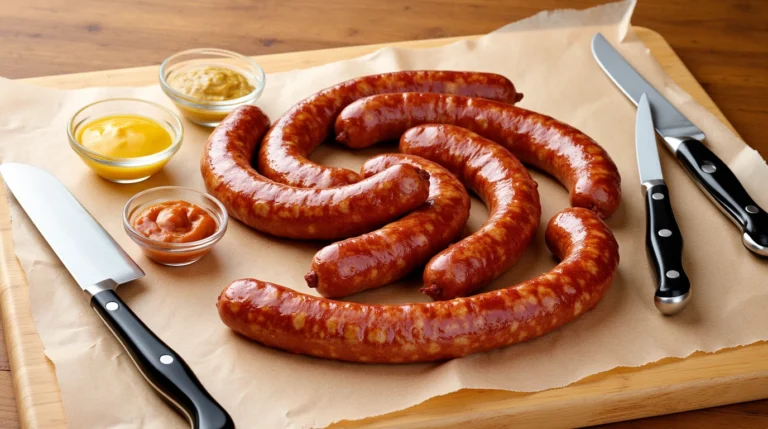Dinty Moore Beef Stew Recipe
Are you craving a hearty meal that reminds you of childhood? The Dinty Moore Beef Stew Recipe is here to help. It turns a classic canned stew into a dish fit for a restaurant, all in your kitchen. Start your journey to making a true classic beef stew today.
If you love cooking at home or want to try something new, this recipe is for you. It’s a guide to making a delicious meal that’s a staple of American comfort food. With just a few ingredients and simple steps, you can make the famous Dinty Moore beef stew at home.
Table of Contents
Key Takeaways
- Learn to transform a classic canned stew into a homemade masterpiece
- Master easy cooking techniques for authentic flavor
- Discover the secrets behind a perfect beef stew
- Create a hearty meal that serves multiple people
- Understand the cultural significance of this classic dish
Understanding the History of Dinty Moore Beef Stew
The story of Dinty Moore beef stew is deeply rooted in American culinary innovation. It was developed in the early 20th century. This canned beef stew quickly became a staple in kitchens across the United States.
Origins of a Culinary Icon
Hormel Foods introduced Dinty Moore beef stew during the Great Depression. It was a time when affordable, convenient meals were needed. The brand was named after a character in a popular newspaper comic strip. This instantly created a memorable identity.
- Founded in the 1930s
- Targeted working-class families
- Designed for quick meal preparation
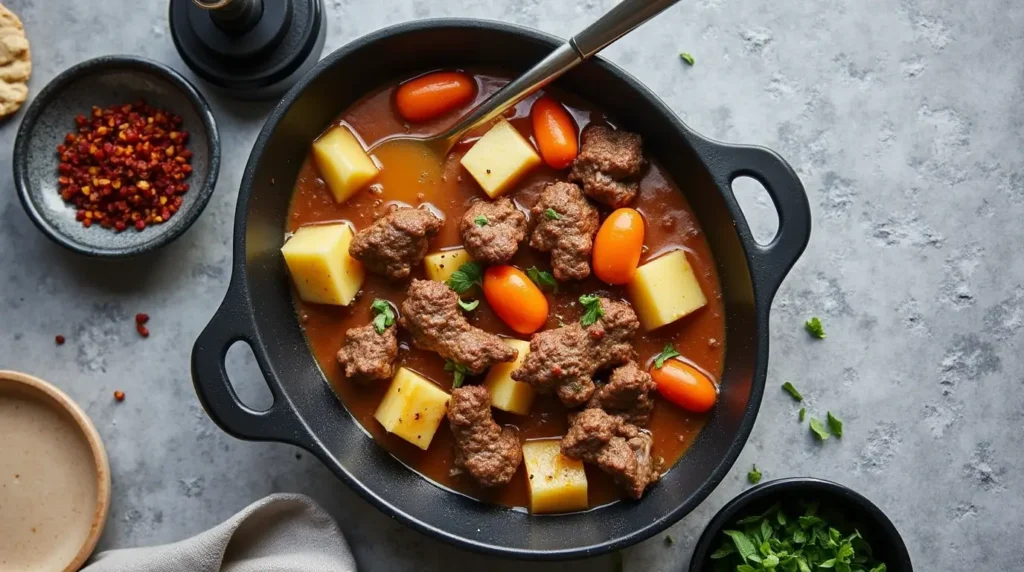
Why This Recipe Became an American Staple
Several key factors propelled Dinty Moore canned beef stew into American households:
| Factor | Impact |
|---|---|
| Convenience | Ready-to-eat meal with minimal preparation |
| Affordability | Low-cost protein source during economic challenges |
| Long Shelf Life | Could be stored for extended periods |
The dinty moore beef stew recipe represented more than just food. It symbolized resilience and practicality during challenging economic times. Its hearty ingredients and robust flavor quickly made it a comfort food for generations of Americans.
“A taste of home, even when times were tough” – Vintage Hormel Advertisement
Essential Ingredients for the Perfect Beef Stew Recreation
Making a hearty beef stew begins with picking the right ingredients. The ingredients you choose will affect the flavor and satisfaction of this classic dish. Let’s look at the key parts that make a simple meal into a tasty experience.
Meat Selection
The base of a great beef stew is quality meat. Go for chuck roast or beef stew meat with lots of marbling. These cuts get tender and soft during cooking, making your stew truly hearty.
Vegetable Essentials
- Potatoes (preferably red or Yukon gold)
- Carrots
- Onions
- Celery
These veggies add nutrition, flavor, and texture to your stew. Cut them into the same size for even cooking.
Flavor Boosters
Enhance your stew with these seasonings:
- Garlic
- Fresh thyme
- Bay leaves
- Worcestershire sauce
- Beef broth
“The secret to a great stew is layering flavors and allowing them to develop slowly.” – Professional Chef
With these ingredients, you’ll make a beef stew that’s as good as any classic. The trick is to be patient and let each ingredient add its own special touch to the dish.
Kitchen Equipment and Tools You’ll Need
To make a tasty beef stew, you need the right tools. Whether you’re cooking on the stovetop or in a slow cooker, the right equipment is key. It makes your cooking experience better.
Essential Cookware for Your Beef Stew
Choosing the right cookware is important for a delicious beef stew. Your cooking pots and pans affect the dish’s texture and taste.
- Heavy-bottomed Dutch oven (5-7 quart capacity)
- Large slow cooker (6-8 quart size)
- Sharp chef’s knife for meat preparation
- Cutting board with non-slip surface
- Wooden spoon or silicone spatula
Optional Cooking Accessories
These accessories are not necessary but can make your stew better and cooking more fun:
- Meat thermometer
- Kitchen scale for precise ingredient measurement
- Vegetable chopper
- Immersion blender for creating smooth sauces

Storage Solutions
Good storage keeps your stew fresh and tasty for later. Think about getting:
- Airtight glass containers
- Freezer-safe plastic containers
- Vacuum sealer for long-term storage
- Portion-sized storage bags
Pro tip: Choose containers that can go from freezer to microwave for maximum convenience.
Step-by-Step Dinty Moore Beef Stew Recipe
Making a tasty dinty moore beef stew at home is simple. This dish adds warmth and comfort to your kitchen. It’s easy to follow with basic cooking steps.
First, get all your ingredients ready and set up your kitchen. The secret to a great beef stew is being prepared and patient.
- Prep Your Ingredients
- Cut beef into 1-inch cubes
- Chop vegetables into uniform pieces
- Measure out seasonings
- Browning the Meat
- Heat oil in a large pot
- Season beef with salt and pepper
- Brown meat until golden on all sides
- Building Flavor
- Sauté onions and garlic
- Add tomato paste
- Deglaze pan with beef broth
Pro tip: Let your stew simmer slowly to develop rich, deep flavors that make this recipe truly special.
| Cooking Stage | Time Estimate | Temperature |
|---|---|---|
| Meat Browning | 10-15 minutes | Medium-high heat |
| Initial Simmering | 1 hour | Low heat |
| Final Cooking | 30-45 minutes | Low heat |
“A great beef stew is all about patience and layering flavors.” – Professional Chef
Your homemade dinty moore beef stew will be full of tender meat, soft veggies, and a rich broth. It’s better than any canned version. Serve it hot with crusty bread for the ultimate comfort meal.
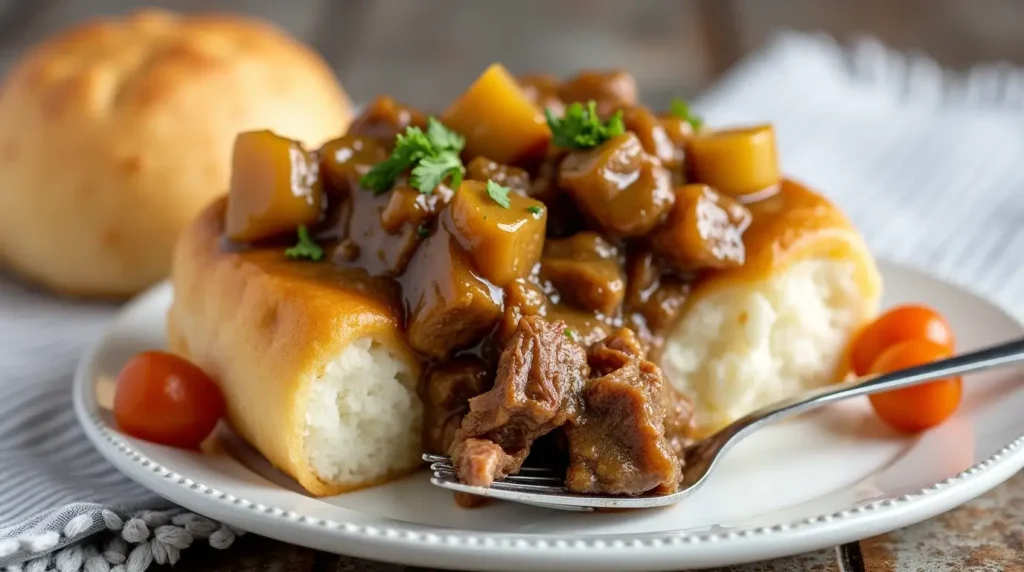
Tips for Selecting and Preparing the Best Beef Cuts
Starting a delicious beef stew begins with picking the right meat. The quality of your meat is key to a great dish. Knowing how to choose, cut, and prepare your beef will make your stew stand out.
Choosing Quality Meat
For stew, choose cuts with good marbling and connective tissue. These features make your meat tender and flavorful. The best cuts for stew are:
- Chuck roast
- Bottom round
- Shoulder cuts
- Brisket
Proper Cutting Techniques
Start with cutting your meat right. Cut it into 1-inch cubes for even cooking. Sharp knives are essential for clean cuts that ensure even cooking.
“The secret to tender beef stew is in the cut and preparation.” – Professional Chef
Meat Preparation Methods
Before cooking, dry your beef with paper towels. This helps get a perfect sear and rich flavors. Seasoning with salt and pepper before cooking boosts the meat’s taste.
- Pat meat dry
- Season generously
- Sear in hot pan before stewing
- Trim excess fat
By following these tips, you’ll make a dish that will wow everyone.
Vegetable Preparation and Seasoning Guide
Creating the best beef stew recipe starts with the right vegetables. The right vegetables can turn a simple stew into a memorable dish. Fresh, well-prepared veggies are key to a rich flavor.
Here’s how to prepare vegetables for your beef stew:
- Wash all vegetables thoroughly under cold running water
- Cut vegetables into uniform, bite-sized pieces for even cooking
- Choose robust vegetables that can withstand long cooking times
Here are some top vegetables for the best beef stew:
- Potatoes: Provide hearty texture and absorb flavors
- Carrots: Add natural sweetness and vibrant color
- Celery: Brings depth and aromatic qualities
- Onions: Create a rich, foundational flavor
“The right vegetable preparation can elevate your beef stew from good to unforgettable.” – Culinary Expert
Seasoning is key in beef stew with vegetables. Use herbs like thyme, rosemary, and bay leaves for flavor. Feel free to try different spice blends to make your stew unique.
Pro tip: Cut root vegetables slightly larger than softer ones. This ensures they cook evenly without becoming mushy. It helps keep your beef stew perfect.
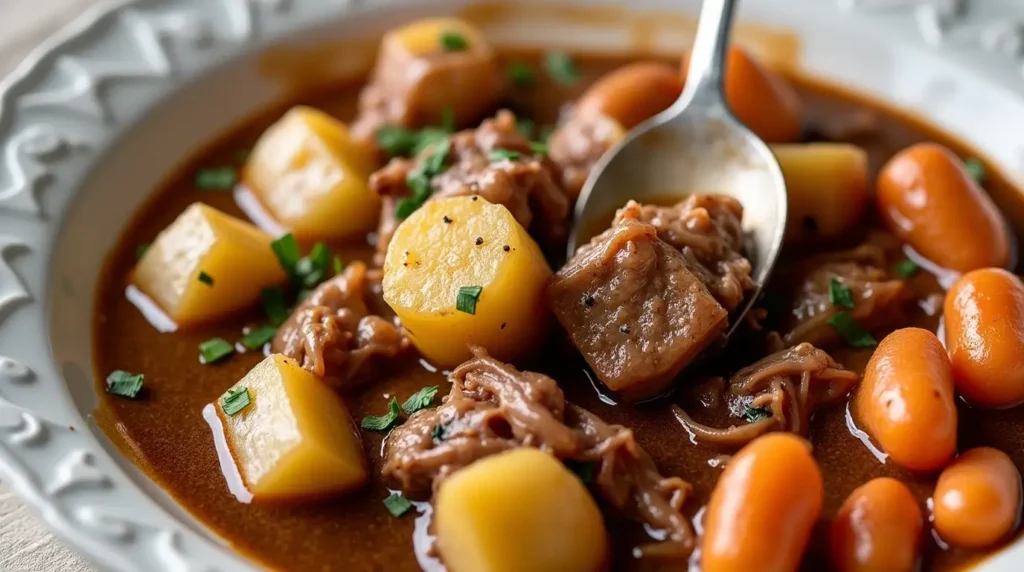
Slow Cooker vs Stovetop Methods
Preparing a delicious slow cooker beef stew offers home cooks two primary cooking methods. Each technique brings unique advantages to creating a hearty meal that warms your kitchen and satisfies your hunger.
Cooking methods can dramatically impact the flavor and texture of your beef stew. Understanding the differences helps you choose the best approach for your schedule and kitchen setup.
Slow Cooker Instructions
The slow cooker method transforms your easy beef stew recipe into a hands-off culinary experience. This technique allows flavors to develop gradually, creating a rich and tender dish.
- Prep time: 15-20 minutes
- Cooking duration: 6-8 hours on low heat
- Ideal for busy home cooks
Traditional Stovetop Technique
Stovetop cooking provides more control and faster results for your slow cooker beef stew. This method requires more active attention but delivers equally delicious outcomes.
| Cooking Method | Prep Time | Total Cooking Time | Flavor Intensity |
|---|---|---|---|
| Slow Cooker | 15-20 minutes | 6-8 hours | Deep, Developed |
| Stovetop | 30-40 minutes | 1-2 hours | Bright, Immediate |
Whichever method you choose, the key is maintaining low, steady heat to ensure meat becomes tender and vegetables absorb rich, savory flavors.
“The secret to an amazing beef stew is patience and quality ingredients.” – Professional Chef
Your choice between slow cooker and stovetop depends on your schedule, kitchen tools, and personal cooking preference. Both methods can produce an incredible easy beef stew recipe that will impress your family and friends.
Storage and Reheating Instructions
Keeping your homemade beef stew fresh is key. It’s important to store and reheat it right. This way, your dish stays rich in flavor and texture.
Here are some tips for storing your beef stew:
- Cool the stew completely before storing
- Use airtight containers to prevent moisture loss
- Refrigerate within two hours of cooking
For short-term storage, the fridge is best. Your stew will stay fresh for 3-4 days there. If you want to keep it longer, freezing is a great choice.
Freezing Guidelines
Freezing your stew means you can enjoy it weeks later. Here’s how to freeze it right:
- Store in freezer-safe containers
- Leave about 1 inch of space for expansion
- Label containers with the date
- Freeze for up to 3 months
Reheating Techniques
To bring back your stew’s flavor, follow these reheating tips:
- Thaw frozen stew in the refrigerator overnight
- Reheat on stovetop over medium-low heat
- Stir occasionally to prevent burning
- Add a splash of broth if the stew seems dry
“The secret to great leftover stew is gentle reheating and a little extra love!” – Professional Chef
Pro tip: Try to avoid microwaving. It can make the meat tough and unevenly heated. Stovetop reheating keeps your stew tasting just as good as when you first made it.
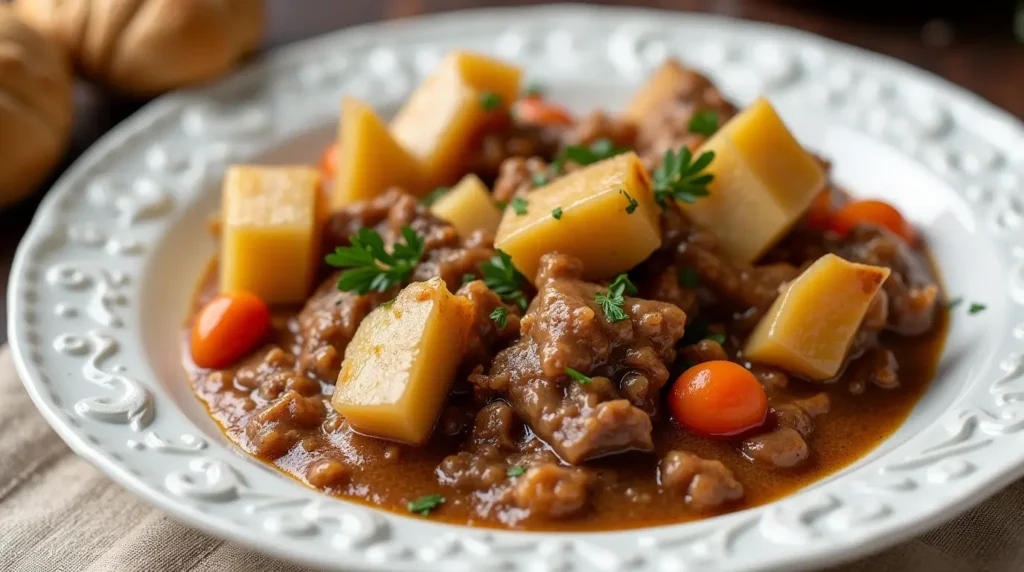
Nutritional Information and Dietary Considerations
Learning about the nutritional facts of beef stew helps you make better choices. Each serving has key nutrients that fit into many diets.
A homemade beef stew has a good mix of protein, veggies, and carbs. Knowing the nutritional details lets you adjust your meal to fit your health goals.
Caloric Content and Macronutrients
The number of calories in beef stew depends on what you add and how you cook it. A typical serving has about 250-350 calories.
| Nutrient | Average Serving (1 cup) |
|---|---|
| Calories | 300 |
| Protein | 20g |
| Carbohydrates | 15g |
| Fat | 12g |
Dietary Modifications
You can change your beef stew to fit different diets:
- Low-sodium: Cut down on salt and use low-sodium broth
- Gluten-free: Use cornstarch instead of wheat-based thickeners
- Low-carb: Add more meat and less potato
- Vegetarian: Use plant-based protein instead of beef
Always talk to a nutritionist for advice that fits your health needs.
Conclusion
Making a classic beef stew like Dinty Moore’s is more than just following a recipe. It’s about creating a dish that warms your heart. Your homemade stew combines rich flavors, tender meat, and cozy veggies in a way store-bought can’t.
This stew is all about being flexible. You can change up the ingredients and seasonings to make it your own. It’s perfect for feeding family, friends, or even just treating yourself to a cozy meal.
Cooking is an art, and every time you make this stew, you’ll get better. Don’t worry about mistakes—each try is a chance to learn and grow. Enjoy the smells in your kitchen and relish every bite of your homemade stew.
Your cooking adventure doesn’t stop here. Keep trying new things and always enjoy the joy of cooking. It brings happiness to you and those you share it with.
FAQ
What makes Dinty Moore Beef Stew a classic American comfort food?
Dinty Moore Beef Stew has been a favorite in American homes for years. It’s known for its hearty ingredients and rich taste. The stew has tender beef, savory veggies, and a delicious gravy, making it a true comfort food.
Can I make a homemade version of Dinty Moore Beef Stew?
Yes, you can make your own version of Dinty Moore Beef Stew. Use beef chuck, potatoes, carrots, and beef broth to get started. Making it at home lets you choose the ingredients and adjust the flavors to your liking.
What are the best cuts of beef for making beef stew?
Chuck roast is the top choice for beef stew. It’s affordable, has lots of marbling, and gets very tender when slow-cooked. Beef round or bottom round are also good, becoming soft and flavorful with long cooking.
How long can I store homemade beef stew?
Homemade beef stew can be stored in the fridge for 3-4 days in a sealed container. For longer storage, it freezes well for 4-6 months. Always cool it down before freezing.
What’s the difference between cooking beef stew in a slow cooker versus on the stovetop?
Slow cookers cook beef stew at a steady, low heat, making the meat tender. Stovetop cooking gives you more control and can change the texture slightly. Both ways can make delicious stew, depending on what you prefer.
Are there any dietary modifications I can make to the beef stew recipe?
Yes, you can adjust the recipe for different diets. For less carbs, use fewer potatoes and add low-carb veggies. For gluten-free, use cornstarch instead of flour. Vegetarians can use mushrooms or plant-based meat.
How can I make my beef stew more flavorful?
To boost flavor, brown the meat before slow cooking. Use herbs like thyme and rosemary, add red wine, and let it simmer slowly. Season well with salt and pepper.
What vegetables work best in beef stew?
Classic stew veggies are potatoes, carrots, and onions. You can also add celery, parsnips, or turnips for more flavor and nutrition. Choose veggies that hold up to long cooking times.




